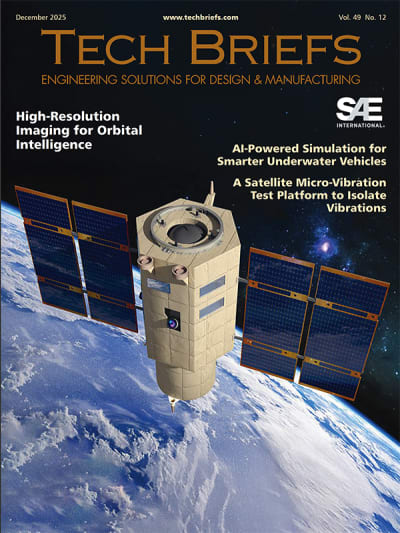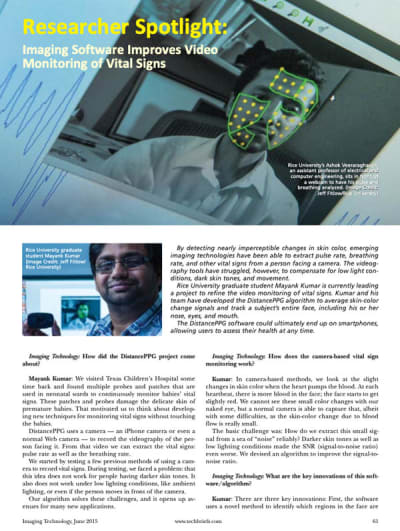Inside this issue
Overview
The June 2015 issue of NASA Tech Briefs presents a wealth of information across various technological domains, focusing on innovations and advancements that are shaping the future of engineering and manufacturing. This edition includes insights into imaging technology, motion control, and automation, showcasing the latest developments and applications in these fields.
Key Highlights:
-
Innovative Technologies: The issue features articles that delve into cutting-edge technologies, including advancements in battery technology, specifically highlighting Tadiran Batteries. These batteries are designed for high-tech devices, emphasizing longevity and reliability, which are crucial for modern applications.
-
DistancePPG Project: One of the standout projects discussed is the DistancePPG initiative, which aims to monitor vital signs such as heart rate and blood oxygen levels without direct contact. This technology leverages advanced imaging techniques to provide non-invasive health monitoring, which could revolutionize patient care, especially in remote or high-risk environments.
-
Manufacturing Insights: The magazine also covers Stratasys Direct Manufacturing, which is at the forefront of additive manufacturing. This section discusses how 3D printing technologies are being utilized to create complex parts and prototypes more efficiently, reducing lead times and costs in the manufacturing process.
Motion Control and Automation: The issue highlights advancements in motion control technologies, which are essential for automation in various industries. Articles explore how these technologies improve precision and efficiency in manufacturing processes, contributing to the overall productivity of operations.
-
Photonics and Imaging Technology: The editorial section dedicated to photonics discusses the latest trends and innovations in imaging technology. This includes advancements in sensors and imaging systems that enhance the capabilities of various applications, from industrial inspection to medical diagnostics.
-
Expert Contributions: The issue features contributions from industry experts, including technical writers and editors who provide in-depth analyses and insights into the latest trends and technologies. Their expertise helps readers understand the implications of these advancements in real-world applications.
-
Subscription and Access Information: For readers interested in further exploring the content, the magazine provides subscription details, including pricing for both domestic and international readers. It also offers information on how to access additional resources and product literature through the Tech Briefs website.
-
Advertising and Reader Services: The magazine includes an index of advertisers, providing readers with easy access to product literature and services. This section is particularly useful for professionals looking to connect with companies that offer innovative solutions relevant to their fields.
-
Editorial Team: The issue is backed by a dedicated editorial team, including the Publisher Joseph T. Pramberger and Editorial Director Linda L. Bell, who ensure that the content is relevant, informative, and engaging for the readership.
In summary, the June 2015 issue of NASA Tech Briefs serves as a comprehensive resource for professionals in engineering, manufacturing, and technology sectors. It highlights significant advancements in various fields, providing insights that can help drive innovation and improve practices within these industries. The combination of expert analysis, detailed articles, and practical information makes this issue a valuable tool for anyone looking to stay informed about the latest technological developments.
Features
-
Application Briefs
Software Helps NASA Simulate Performance of James Webb Telescope
Tech Briefs
-
Manufacturing & Prototyping
Aluminum Rocket Engine Injector Fabricated Using 3D Additive Manufacturing
Making Flexible Ablators that are Flexible Char Formers
Method for Providing Semiconductors Having Self-Aligned Ion Implant
-
Materials
Regenerable Trace-Contaminant Sorbent for the Primary Life Support System (PLSS)
Lithium Fluoride as a Polysulfide Shuttle Inhibitor for Lithium Sulfur Chemistry
Fibers of Aligned Single-Wall Carbon Nanotubes and Process for Making the Same
-
Information Sciences
Tool for Turbine Engine Closed-loop Transient Analysis (TTECTrA)
Wald Sequential Probability Ratio Test for Space Object Conjunction Assessment
Next Generation of 3DGRAPE: Flexible Framework for Hypersonic Navier-Stokes Shuttle Orbiter Meshes
Delay Tolerant Link State Routing MACHETE Model
Extendable Uniform Remote Operations Planning Architecture (EUROPA) 2.1
Acoustic Emission Analysis Applet (AEAA) Software
Software-Defined Beacon Receiver Implementation Using Frequency Estimation Algorithms
CT-CURS: Computed Tomography Cylinder Data Unwrapping-Reslicing & Analysis, v2
-
Electronics & Computers
Hardening Electronics Against Difficult High-Temperature Environments
Stacked Capacitor Special Lead Adapter
Nanoscale Vacuum Channel Transistor
Three-Dimensional Photovoltaics Array for Laser-Based Power Transfer
-
Sensors/Data Acquisition
Free Space Optical Receiver for Data Detection and Radio Science Measurements
Precision Miniature Attitude Determination and Control System
Combined Detection and Tracking of Moving Objects in Aerial Surveillance Images
Neo-Geography Toolkit (NGT) v2
Physical Characterization of Radiated and Non-Radiated Materials to Temperatures Less than 50 K
Worldview Satellite Imagery Browsing and Downloading Tool
Method and Device for Biometric Subject Verification and Identification
SMAP Radiometer Instrument Science Signal and Data Processing Software (SPS)
-
Photonics/Optics
Enhancing Neutron Imaging with Grazing Incidence Optics
Motion Blur Evaluation Techniques
Illuminating Permanently Shadowed Lunar Regions Using a Solar Sail
Products
-
Articles
Researcher Spotlight: Imaging Software Improves Video Monitoring of Vital Signs
High Dynamic Range Imaging (HDRI) Upgrades Inspection Results
-
Applications
Advanced Holography Offers 3D Fire Measurements
Cameras Provide Critical Data for NASA Rocket’s First Flight




